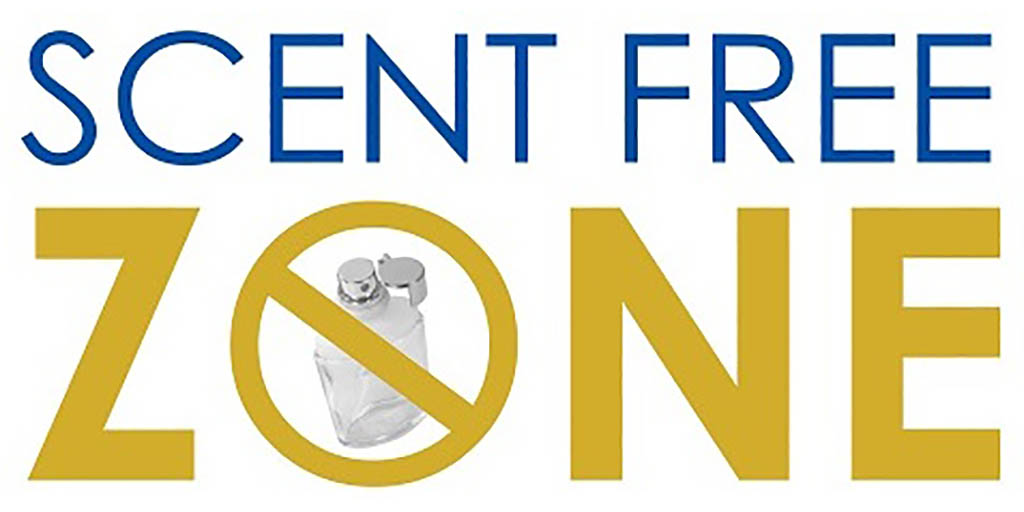
Fragrance is not the first thing that comes to mind when most people think about accessibility; however, fragrances can be a physical access barrier for many people. According to a study published in the journal Air Quality, Atmosphere & Health, approximately one in three Americans experience adverse medical reactions to fragrance exposure, including asthma attacks, migraines, and the life-threatening allergic reaction called anaphylaxis.
Fragrance-containing parfum and essential oils emit volatile organic compounds (VOCs), which are a major source of indoor air pollution. Unfortunately, U.S. law deems fragrance ingredients a “trade secret.” Therefore, manufacturers are not required to disclose the ingredients used in their fragrances, which means products that list “fragrance” or “parfum” in the ingredients may contain toxins, carcinogens (cancer-causing chemicals), and endocrine disruptors.
So-called “natural fragrances” aren’t always safe either. According to a study published in the journal Epilepsy Research, essential oils such as eucalyptus and camphor have a pro-convulsant effect, triggering seizures in some people. An added concern with essential oils is that many of them are toxic to dogs and cats which people with disabilities may use as assistance animals.
Beware of labels using terms like “fragrance-free” and “unscented.” Although a product marked “fragrance-free” will not contain the ingredients “fragrance” or “parfum,” it may still contain individually listed fragrance ingredients and essential oils, which are not safe for some people with fragrance-reactive disabilities. Additionally, products labeled as “unscented” may use fragrance chemicals to mask the natural scent of the ingredients and may also not be safe. Checking the ingredients list is the best way to confirm that a product is truly free from fragrance-related chemicals.
Eliminating unnecessary products such as air fresheners and scented candles, and switching to fragrance/parfum-free products for necessary items such as cleaning products, detergents, and soaps, would make air quality healthier for everyone and the spaces you are in more accessible and inclusive for people with disabilities. These measures would be a good start, but the fragrance issue really needs to be addressed on a systemic level throughout our culture. Avoiding other people who may wear fragrances does not work if facilities themselves are not fragrance-free. Places of public accommodation should be able to provide customers with ingredient lists or the Safety Data Sheet for the products used in their facilities as a reasonable accommodation for customers with fragrance-reactive disabilities to ensure the environment is safe to enter.
Sadly, the most life-threatening issue for people with fragrance-reactive disabilities is a lack of access to healthcare. Healthcare facilities now recognize the importance of air quality by enforcing smoke-free facilities, yet most continue to ignore the impact of second-hand scent. Far too many people with disabilities are forced to go without healthcare because providers are unwilling to make the change to fragrance-free cleaning products.
In February 2022, the National Council on Disability (NDC) published a new Health Equity Framework for People with Disabilities, which in part calls on the U.S. Department of Health & Human Services (HHS) Office of Civil Rights to establish industry guidance addressing the needs of people who are disabled by exposure to fragrances. Section six under “Additional Components of NCD’s Health Equity for People with Disabilities Framework” specifically states:
“Provide mandatory industry guidance, including recommended policies, training and best practices, to address the needs of people disabled by exposure to low level chemical, electromagnetic, and other environmental exposures that preclude access to care and treatment at medical, dental and at other providers’ offices, hospitals, surgical centers, and other healthcare and healthcare–related facilities, as a result of their use of chemical, fragranced, and other scented products, which may trigger disabling and life-threatening cardiac, respiratory, neurological, and other adverse physical reactions.”
In October 2021, U.S. Representative Jan Shakowsky (D-IL) introduced House Bill H.R. 5538, the Cosmetic Fragrance and Flavor Ingredient Right to Know Act. This legislation would require manufacturers to disclose the fragrance ingredients used in their cosmetics and personal care products. Currently, the bill is sitting in the U.S. House Committee on Energy & Commerce Subcommittee on Health. Michigan members of this subcommittee include Representatives Debbie Dingell (D) and Fred Upton (R).
For the health, safety and well-being of everyone, we need to be proactive about making all public spaces in our communities truly fragrance-free.
Ways you can DARE to Impact Change:
- If your U.S. Representative is on the U.S. House Committee on Energy & Commerce Subcommittee on Health, you can contact them to request they support the bill’s passage through committee. Even if your representative is not on the committee, you can ask them to co-sponsor this legislation.
- You can contact the Health & Human Services Office of Civil Rights to encourage them to act on the Health Equity Framework for People with Disabilities.
- If you work in healthcare (or anywhere that’s open to the public), talk to your facilities management team about making the switch to fragrance-free cleaning products. The American Lung Association provides a sample letter to building management that you could use to craft your letter.
- If you are employed, talk to the Human Resources Director about implementing a fragrance-free workplace policy. The American Lung Association provides a sample fragrance-free policy to help get them started.
More Information on the Topic:
- Invisible Disabilities Association – Cleaner Indoor Air Campaign
- UCLA Center for the Study of Women – Accessible Spaces Fragrance-free Toolkit
- Job Accommodation Network – Accommodation & Compliance
Note: This article is a publication of Disability Network Southwest Michigan and was written for our DARE to Impact Change publication which provides Disability Advocacy, Rights & Education. Follow this link for more info and to subscribe to our DARE to Impact Change e-publication.
